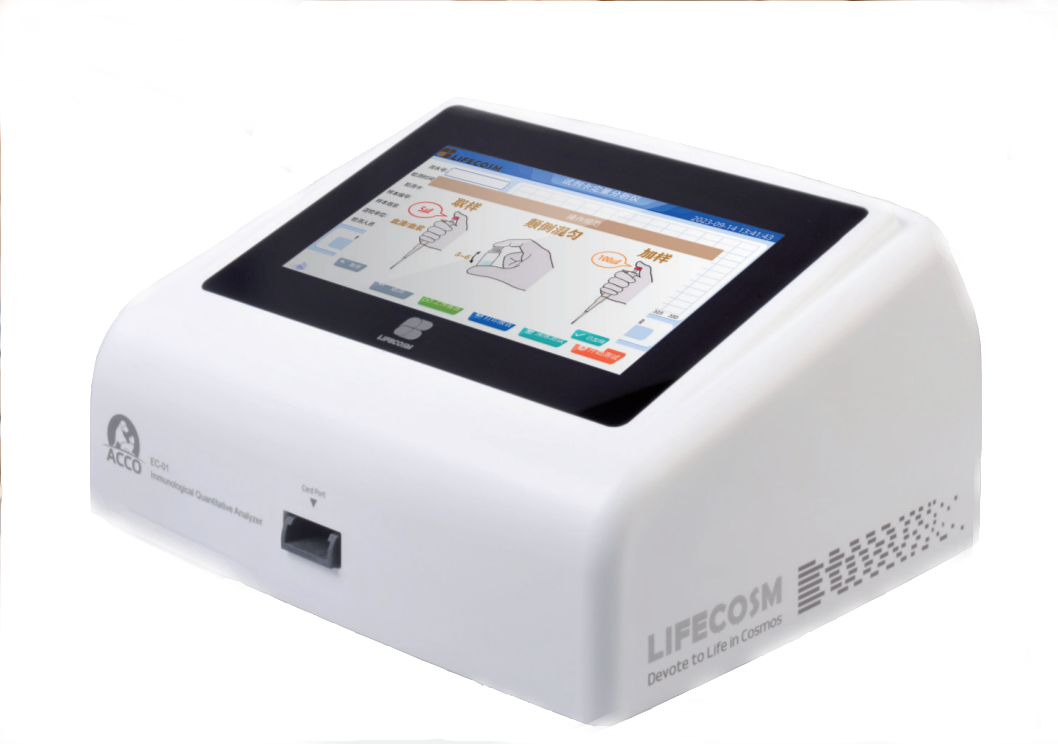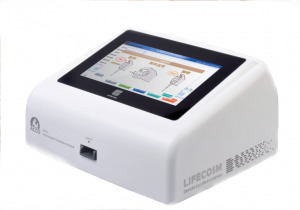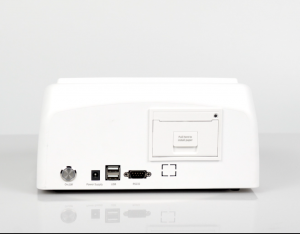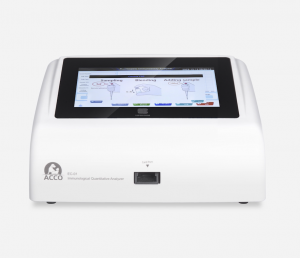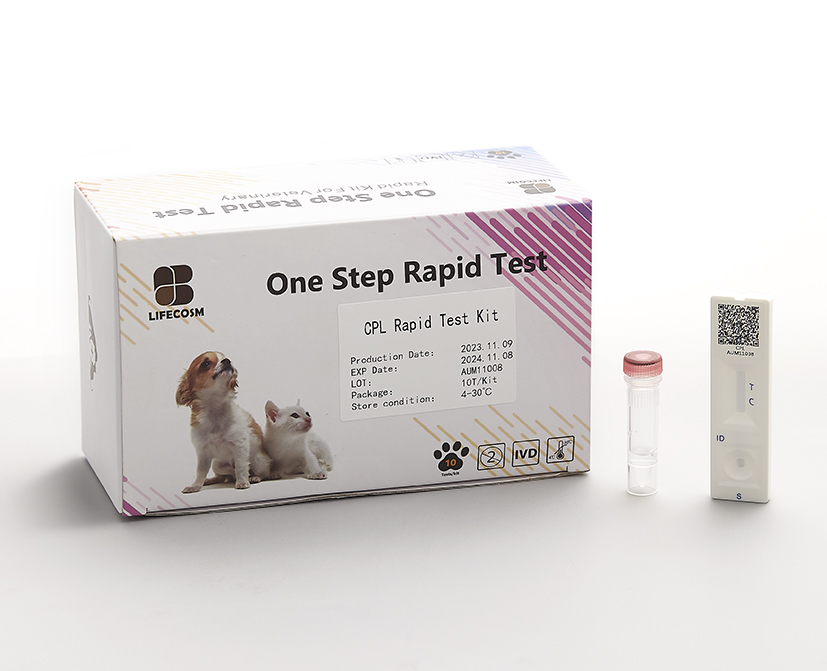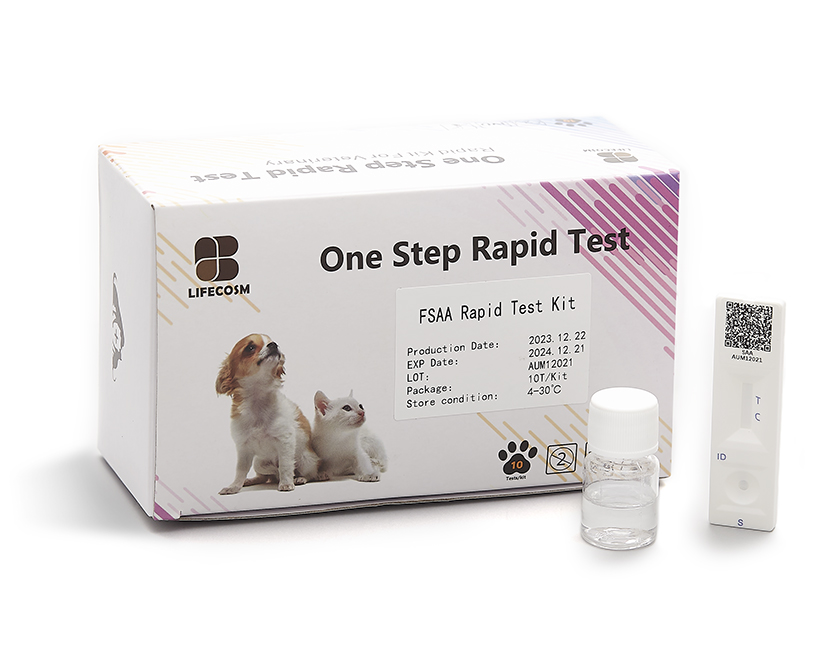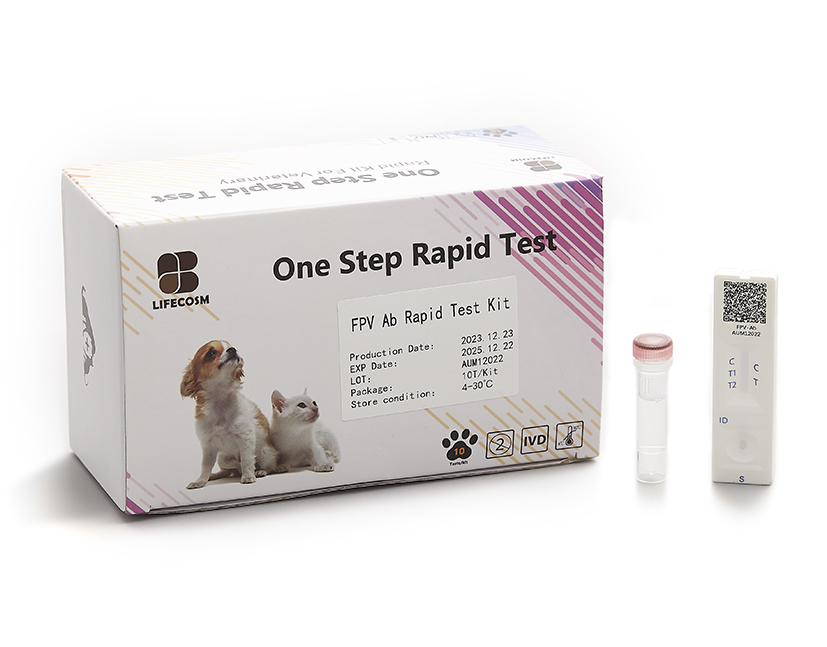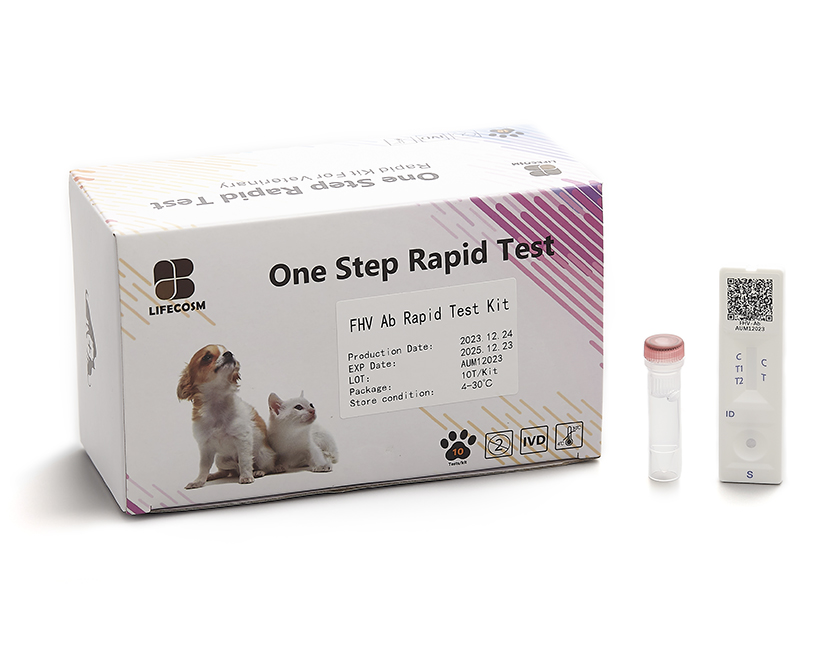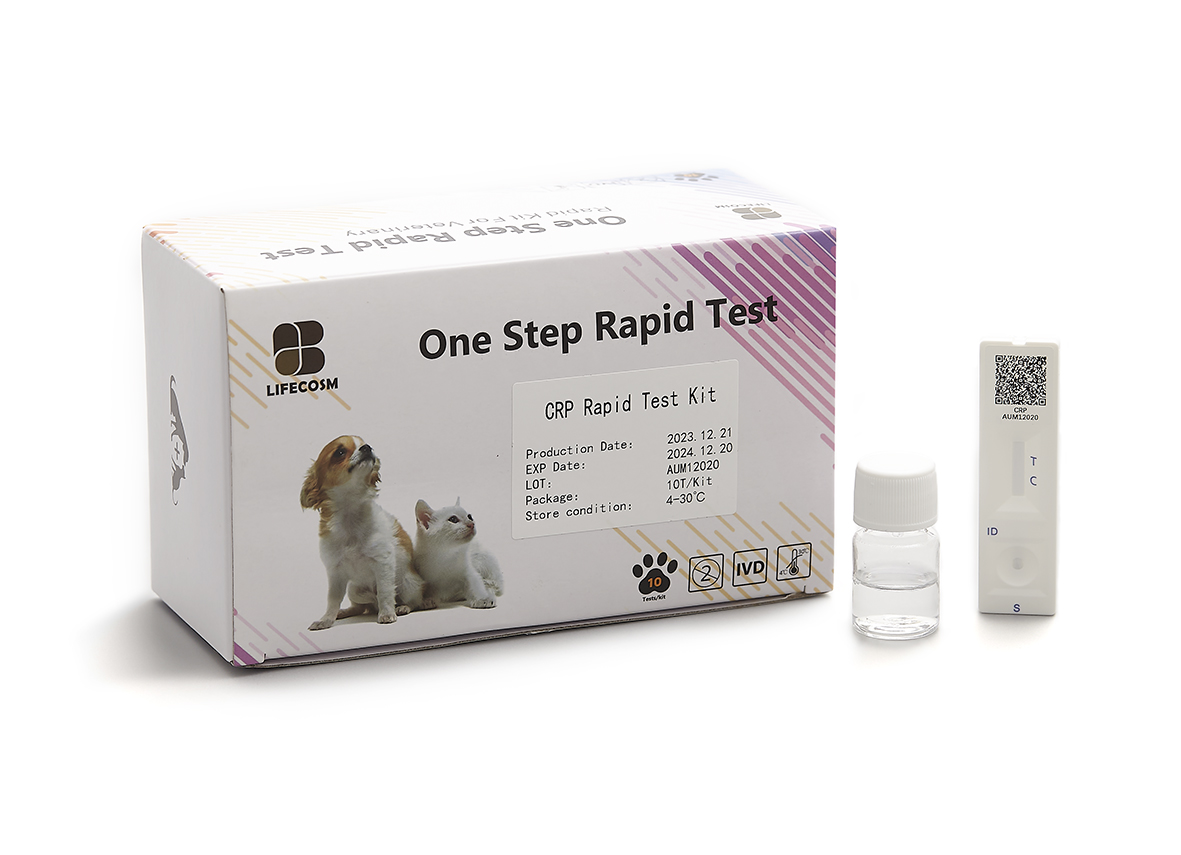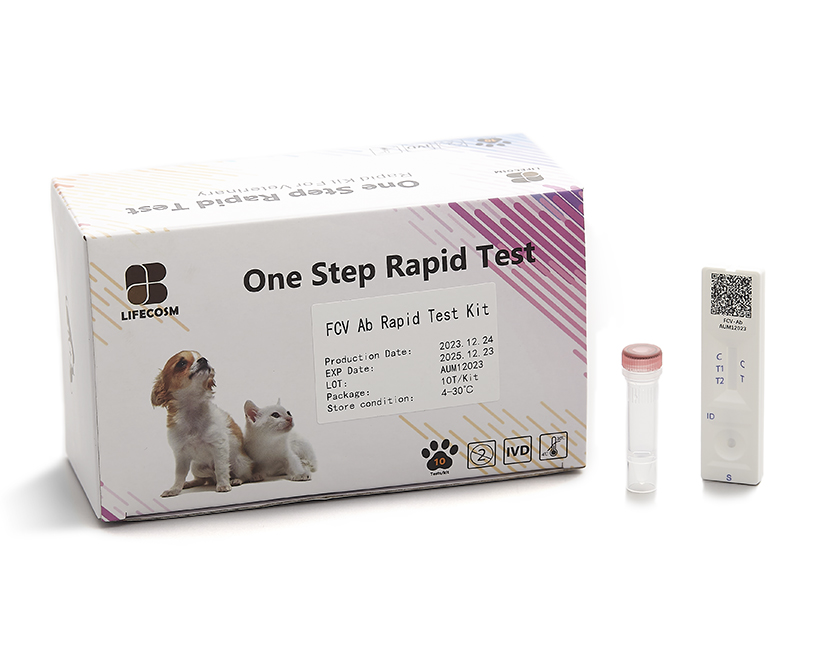
Products
Lifecosm Immunological quantification analyzer
| Power supply voltage: AC 220V 50Hz |
| Analysis efficiency: <25min |
| Accuracy: the relative deviation is within ± 15% |
| Dimensions: 235X190X120mm |
| Storage conditions: storage at room temperature |
| Relative humidity: 45%~75% |
| Power: <100VA |
| Coefficient of variation (CV) of 1.5% |
| Data interface: 1 data interface |
| Weight: 1.5kg |
| Working environment: temperature:-10°C~40°C |
| Atmospheric pressure: 86.0kPa~106.0kPa |
|
Immunological quantification analyzer |
|
| Immunological quantification analyzerColloidal gold / fluorescence detection 2 in 1 | |
| Catalog number | EC-01 |
| Summary | This instrument is capable of reading and analyzing both colloidal gold test cards and fluorescent test cards. |
| Principle | The analyzer first reads the information in the two-dimensional code on the Test card, identifies the paper as colloidal gold, activates the colloidal gold-excited light (525nm), and irradiates the detection area (T line) and quality control area (C line) through the integrated light path |
| Scope of application | This product utilizes chromatographic immunoassay technology and is compatible for use with fluorescent and colloidal gold test card." |
| Applications | Colloidal gold / fluorescence |
| Reading time | 10 ~ 15 minutes |
|
Instructions for Use |
This analyzer utilizes a capacitive touchscreen display for operation, allowing users to navigate through the menu options using the buttons displayed on the screen."
|
Instrument technical parameters
| Power supply voltage: AC 220V 50Hz | Power: <100VA |
| Analysis efficiency: <25min | Coefficient of variation (CV) of 1.5% |
| Accuracy: the relative deviation is within ± 15% | Data interface: 1 data interface |
| Dimensions: 235X190X120mm | Weight: 1.5kg |
| Storage conditions: storage at room temperature | Working environment :temperature:
-10°C~40°C |
| Relative humidity: 45%~75% | Atmospheric pressure: 86.0kPa~106.0kPa |
System components and structures

Prevention
The most effective way to prevent infection is to prevent exposure to FeLV- infected cats. Testing to identify infected cats is the mainstay of preventing transmission of FeLV. FeLV vaccination should not be considered a substitute for testing cats.
Information
Virologists classify feline immunodeficiency virus (FIV) as a lentivirus (or "slow virus"). FIV is in the same retrovirus family as feline leukemia virus (FeLV), but the viruses differ in many ways including their shape. FIV is elongated, while FeLV is more circular. The two viruses are also quite different genetically, and the proteins that compose them are dissimilar in size and composition. The specific ways in which they cause disease differ, as well.
FIV-infected cats are found worldwide, but the prevalence of infection varies greatly. In the United States, approximately 1.5 to 3 percent of healthy cats are infected with FIV. Rates rise significantly-15 percent or more-in cats that are sick or at high risk of infection. Because biting is the most efficient means of viral transmission, free-roaming, aggressive male cats are the most frequently infected, while cats housed exclusively indoors are much less likely to be infected.
Transmission
The primary mode of FIV transmission is deep bite wounds, whereas FeLV is easily spread by casual contact such as grooming and shared water bowls.
Experts disagree as to whether FIV can be spread by casual contact. The virus is also transmitted via mucosal surfaces such as those in the mouth, rectum, and vagina.
Symptoms
Early in the course of infection, the virus is carried to nearby lymph nodes, where it reproduces in white blood cells known as T-lymphocytes. The virus then spreads to other lymph nodes throughout the body, resulting in a generalized but usually temporary enlargement of the lymph nodes, often accompanied by fever. This stage of infection may pass unnoticed unless the lymph nodes are greatly enlarged.
An infected cat's health may deteriorate progressively or be characterized by recurrent illness interspersed with periods of relative health. Sometimes not appearing for years after infection, signs of immunodeficiency can appear anywhere throughout the body. Signs are as follows:
√Poor coat condition and persistent fever with a loss of appetite are commonly seen.
√Inflammation of the gums (gingivitis) and mouth (stomatitis) and chronic or recurrent infections of the skin, urinary bladder, and upper respiratory tract are often present.
√Persistent diarrhea can also be a problem, as can a variety of eye conditions.
√Slow but progressive weight loss is common, followed by severe wasting late in the disease process.
√Various kinds of cancer and blood diseases are much more common in cats infected with FIV, too.
√In unspayed female cats, abortion of kittens or other reproductive failures have been noted.
√Some infected cats experience seizures, behavior changes, and other neurological disorders.
Diagnosis
Diagnosis is based on the history, the clinical signs, and the result of an FIV antibody test. Detection of FIV antibody is the diagnostic test of choice, because the levels of virus in the blood of an infected cat are frequently so low as to be undetectable by conventional means. Currently available FIV tests (ELISA, Western blot test, and other immunochormatographic test) detects antibodies directed against the virus. Most cats develop antibodies to FIV within 60 days after infection. However, the time required for seroconversion is extremely variable and may be considerably longer than 60 days in some instances. A positive FIV antibody test indicates that a cat is infected with FIV (probably for its lifetime-established infections are rarely cleared) and is capable of transmitting the virus to other susceptible cats. it should be noted that eight to twelve weeks (and occasionally more) may elapse after infection before detectable antibody levels appear.
Some researchers caution that disease pathogenesis, such as regressive infections and lack of circulating p27 antigen in some cats with FeLV infection, can complicate accurate diagnosis. Further, the use of FIV vaccines may also complicate accurate point-of-care testing because distinction between infection-induced versus vaccine-induced antibodies is difficult
Prevention
The only sure way to protect cats is to prevent their exposure to the virus. Cat bites are the major way infection is transmitted, so keeping cats indoors- and away from potentially infected cats that might bite them-markedly reduces their likelihood of contracting FIV infection. For the safety of the resident cats, only infection-free cats should be adopted into a household with uninfected cats.
Vaccines to help protect against FIV infection are now available. However, not all vaccinated cats will be protected by the vaccine, so preventing exposure will remain important, even for vaccinated pets. In addition, vaccination may have an impact on future FIV test results. It is important that you discuss the advantages and disadvantages of vaccination with your veterinarian to help you decide whether FIV vaccines should be administered to your cat.

